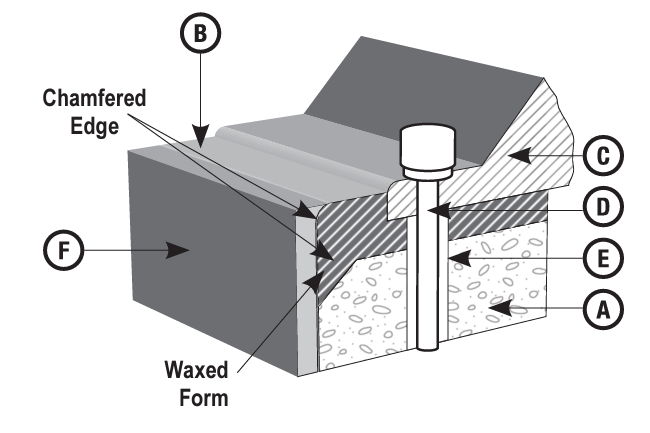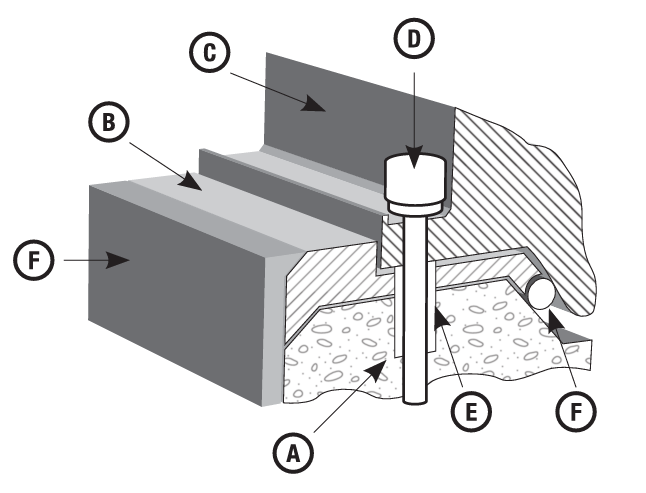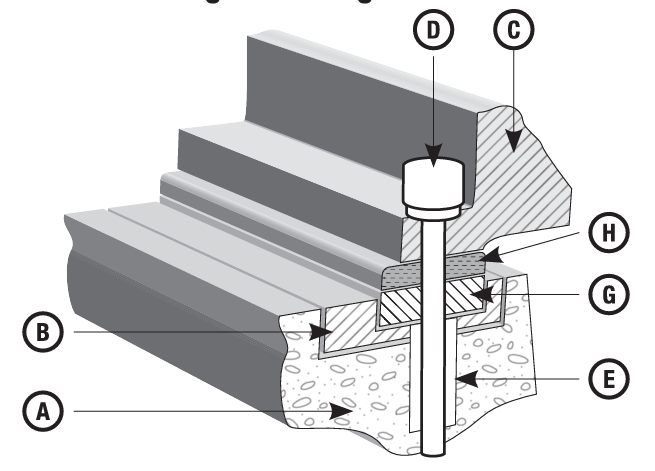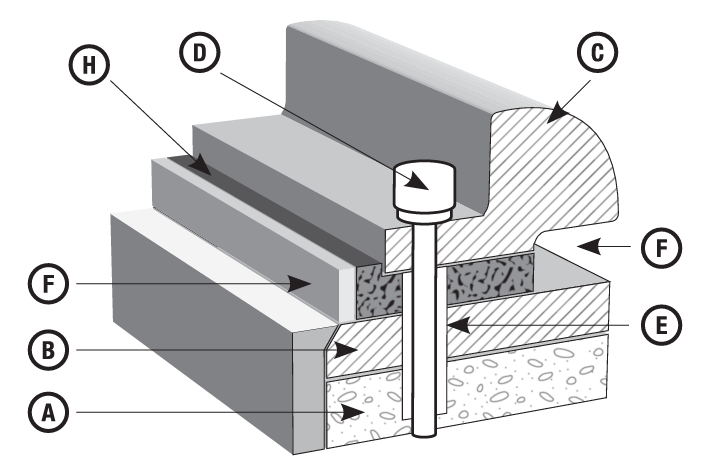
SikaFlow®-649
(formerly MFlow 649)
SikaFlow®-649 grout is a high-performance epoxy grouting material for support of heavy equipment. It ensures the proper transmission of static and dynamic loads to the equipment foundation.
- High early and ultimate strengths with low creep for rapid turnaround
- Superior physical properties at high temperatures increases the range of in-service temperatures
- Excellent bearing area of 85% achievable (for even load distribution) when following proper grouting procedures
- Good chemical resistance
- Resists impact and dampens torque
- Durable bond to concrete and steel optimizes load transfer
- Meets the requirements of American Petroleum Institute (API); API Standard 610 and API Recommended Practice 686 for rotating equipment
Usage
- Precision alignment of compressors, generators, pumps and electric motors
- Pour-back grouting for post-tensioning cables
- Crane rail grouting
- Grouting of crusher ball mills, slab tables and other equipment subject to high torque, impact and vibration
- Grouting of wind turbine tower bases
- Grouting of anchors, bars and dowels
Advantages
- High early and ultimate strengths with low creep for rapid turnaround
- Superior physical properties at high temperatures increases the range of in-service temperatures
- Excellent bearing area of 85% achievable (for even load distribution) when following proper grouting procedures
- Good chemical resistance
- Resists impact and dampens torque
- Durable bond to concrete and steel optimizes load transfer
- Meets the requirements of American Petroleum Institute (API); API Standard 610 and API Recommended Practice 686 for rotating equipment
Packaging
230 lb unit (1.73 ft3 [0.049 m3])
- 22.3 lb (10.1kg) pail Part A
- 7.6 lb (3.4kg) bottle Part B
- 4 x 50 lb (22.7kg) bags Part C
All components packaged separately.
May be ordered as a 3-bag high-flow unit.
Product Details
Chemical Base
SikaFlow®-649 grout is three-component modified epoxy-resin-based grout.
Shelf Life
1.5 years (for both resin and hardener) when properly stored
Storage Conditions
Store in unopened containers at 60 to 80 °F (16 to 27° C) in clean, dry conditions.
Density
| Filled 5.75 :1 | 129lb/ft3 (2,064kg/m3) |
| Filled 6.25 :1 | 131lb/ft3 (2,096kg/m3) |
| Filled 6.75 :1 | 133lb/ft3 (2,128kg/m3) |
Abrasion Resistance
Better than concrete
Impact Strength
Better than concrete
Compressive Strength
Compressive strength of 2 by 2" cubes, filled 6.25:1 when cured at:
| Time | 55° F (13° C) | 73° F (23° C) | 90° F (32° C) |
| 8 hours | - | 700psi (5MPa) | 9,400psi (65MPa) |
| 16 hours | - | 7,000psi (48MPa) | 13,700psi (96MPa) |
| 24 hours | 1,300psi (9MPa) | 11,500psi (81MPa) | 16,000psi (112MPa) |
| 48 hours | 9,400psi (65MPa) | 16,400psi (115MPa) | 18,500psi (130MPa) |
| 72 hours | 13,900psi (96MPa) | 17,100psi (118MPa) | 19,000psi (134MPa) |
| 96 hours | 16,700psi (115MPa) | 18,000psi (124MPa) | 20,000psi (141MPa) |
Flexural Strength
| Temp | filled 6.25:1, cured 7 days at 73° F (23° C) |
| 76° F (24° C) | 4,600psi (32MPa) |
| 140° F (60° C) | 4,200psi (29MPa) |
| 170° F (77° C) | 2,100psi (15MPa) |
Modulus of Elasticity in Flexure
| Test Temp | Fill ratio: 5.75 | Fill ratio: 6.25 | Fill ratio: 6.75 |
| 76° F (24° C) | 2.5 x 106 psi (18 GPa) | 2.5 x 106 psi (18 GPa) | 2.6 x 106 psi (18 GPa) |
| 110° F (43° C) | 2.1 x 106 psi (15 GPa) | 2.3 x 106 psi (16 GPa) | 2.3 x 106 psi (16 GPa) |
| 125° F (52° C) | 2.0 x 106 psi (14 GPa) | 2.1 x 106 psi (15 GPa) | 2.1 x 106 psi (15 GPa) |
| 140° F (60° C) | 1.6 x 106 psi (11 GPa) | 1.7 x 106 psi (12 GPa) | 1.8 x 106 psi (12 GPa) |
| 155° F (68° C) | 0.7 x 106 psi (5 GPa) | 0.7 x 106 psi (5 GPa) | 0.9 x 106 psi (6 GPa) |
Tensile Strength
| Filled 6.25:1 : 2,300 psi (16 MPa) |
Tensile Adhesion Strength
Bond strength to steel
| 73° F (23° C) | 3,100 psi (21 MPa) |
| 140° F (60° C) | 2,000 psi (14 MPa) |
Slant Shear Strength
Bond strength to steel
| 73° F (23° C) | 5,000 psi (35 MPa) |
| 140° F (60° C) | 2,000 psi (14 MPa) |
Creep
| Over 24 hours: 2.8 x 10-3 |
| Over 1 year: 3.7 x 10-3 |
| Over 10 years: 4.0 x 10-3 |
Shrinkage
| 0.00065 linear, in/in, filled 6.25:1 | (ASTM C 531) |
Coefficient of Thermal Expansion
| 31 – 74°F (0 – 23°C) | 11.8 x 10-6in/in/°F (21.2 x 10-6cm/cm/°C) |
| 74 – 110°F (23 – 43°C) | 13.0 x 10-6in/in/°F (23.4 x 10-6cm/cm/°C) |
| 74 – 210°F (23 – 99°C) | 21.8 x 10-6in/in/°F (39.2 x 10-6cm/cm/°C) |
Water Absorption
| 0.076% filled 6.25 : 1 | (ASTM C 413) |
Application
Flowability
Materials Removed or Added
| Temperature | Thin Pours or Long Flow Distances Under Equipment | Standard Pours | Thick Pours, Open Areas, or Short Flow Distances |
| Above 90°F (32°C) | - | - | 1/2 – 1 bag (Add 3.8 L) |
| 70 – 90°F (21 – 32°C) | Up to 1/2 bag | - | 1/2 bag |
| 50 – 70°F (10 – 21°C) | 1/2 to 1 bag | 1/2 bag | 1/2 bag |
Mixing Ratio
- The fill ratio is the weight of aggregate compared to the combined resin and hardener components. SikaFlow®-649 is used at a variable fill ratio from the standard 6.75: 1 ratio to as low as 5.06:1 (high-flow version).
- The standard 1.73 ft3 (0.049 m3) unit of SikaFlow®-649 includes 188 lbs (85.2 kg) of aggregate (or four 47 lb bags). This 6.75:1 fill ratio can be reduced to as low as three bags or a 5.06:1 fill ratio yielding 1.34 ft3 (0.038 m3).
- For projects requiring a fill ratio different from the standard 4 bag mix, simply determine how many bags of aggregate will be used (number of bags x number of units) and purchase the components (resin, hardener, and aggregate) separately.
Fill Ratio Guideline
1.73 ft3 Unit
| Temperature | Very Thin Pours or Very Long Distances | Standard Pours |
| >90° F (> 32° C) | - | - |
| 70 to 90° F (21 to 32° C) | Up to 1/2 bag | - |
| 50 to 70° F (10 to 21° C) | 1/2 to 1 bag | 1/2 bag |
The chart above provides guidelines for the amount of aggregate that can be removed from a 1.73 ft3 unit in order to optimize flow and cost per ft3. A maximum of 12 lbs of aggregate can be removed from a 0.43 ft3 unit.
Thinner
The following chart shows the working time for a fresh grout mix at various ambient temperatures. The working time begins when the hardener is added to the resin. Do not let resin and hardener stand without adding aggregate. This material produces an exothermic. If the material exotherms without aggregate, the temperature can cause decomposition or gassing, releasing potentially hazardous fumes. If the catalyzed resin cannot be used immediately, spread the material over a large open surface, which will allow the heat to dissipate normally. These working times assume product has been properly preconditioned for cold or hot weather use.
Working Time
| Temperature | Time |
| 90°F (32° C) | 50–60 min |
| 70°F (21° C) | 90–120 min |
| 50°F (10° C) | 120–150 min |
MIXING
This product when discarded or disposed of, is not listed as a hazardous waste in federal regulations. Dispose of in a landfill in accordance with local regulations. For additional information on personal protective equipment, first aid, and emergency procedures, refer to the product Safety Data Sheet (SDS) on the job site or contact the company.
Coverage
230 lb unit is 1.73 ft3 (0.049 m3)
May be ordered as a 3-bag high-flow unit, which will yield 1.35 ft3 (0.038 m3).
When estimating project requirements, be sure to account for application variables.
NOTES ON INSTALLATION
- Do not add solvent, water, or any other material to the grout.
- Do not alter the resin or hardener proportions.
- Contact your local representative for a pre-job conference to plan the installation.
- For guidelines on specific anchor-bolt applications, contact Technical Service.
- Always use a head box when placing less than 1” (25 mm) depth.
- The substrate temperature must be greater than 50° F (10° C).
- Cold material will exhibit decreased flowability and reduced strength development.
- The minimum placement thickness is 1/2” (13 mm). Consult your Sika representative before placing lifts more than 6” (152 mm) in depth.
- Chamfering the concrete edge helps reduce thermal cracking. Following proper installation procedures also reduces the potential for cracking.
- For professional use only; not for sale to or use by the general public.
- Make certain the most current versions of the product data-sheet and SDS are being used.
- Proper application is the responsibility of the user. Field visits by Sika personnel are for the purpose of making technical recommendations only and not for supervising or providing quality control on the jobsite.
Figure 1 - Regular Equipment

Figure 2 - Engine with Oil Pan

Figure 3 - Rail or Soleplate

Figure 4 - Typical Rail With Expansion Joint Section

Figure 5 - Typical Epoxy Chock Application

Key
| A.Concrete Foundation | B.Grout |
| C.Equipment Base | D.Anchor Bolt |
| E.Anchor Bolt Sleeve Seal | F. Form |
| G.Soleplate or Rail | H.Shim or Chock |
| I. Expansion Joint |
EQUIPMENT
- If rust scale is present, abrade the bonding surfaces of the base to be grouted; it must be free of coatings, wax, grease, or scale. Mechanical methods, such as grinding or sanding, will suffice, but do not produce as high a bond strength as sandblasting.
- Primer should be used ONLY when a long delay between cleaning and grouting could allow excessive rusting or contamination. If the base must be primed, use SikaEmaco® ADH 1090 RS from Sika. If the primer has been on the surface for more than 1 month, abrade and solvent wipe it so that no residue remains.
- The grout should come up at least 3/4" (19 mm) onto the equipment. Protect the area above it with masking tape.
- To facilitate cleanup, wax or cover all surfaces where the grout may splash or spill.
SUBSTRATE PREPARATION
- Protect the foundation and equipment from rain or moisture. Water will prevent grout bond and inhibit cure.
- Seal off areas that will not be grouted.
- Place forms no greater than 6" (152 mm) away from the edge of the individual base rail or sole- plate on the sides where the grout is not being poured. Excessive edges create thermal stress and result in excessive cracking. Formwork edges should allow enough room to accommodate pouring of the grout and accommodate a headbox, is used. Shoulders should be a maximum of 6” in width. However, this may vary depending on the application. Moderate to large-size equipment and difficult or narrow placement applications should utilize an extended head form (headbox) to create additional head pressure and to enhance placement. Consult your Sika representative for specific recommendations.
- Before erecting the forms, cover them with extra-heavy coats of paste wax. Forms can be shellacked before waxing to improve release. Keep wax off concrete and steel surfaces. As an alternative to waxing, a polyethylene or other non-bondable film may be used as a release agent. The top of the form should extend at least 3/4" (19 mm) above the bottom of the rail or plate.
- Forms must be liquid tight. Seal forms to vertical concrete surface by applying putty, foam, or caulk below top of concrete and then press form into place.
- Expansion joints will reduce the possibility of cracking. On multiple soleplate installations, each soleplate may be isolated. Expansion joints can be made with any material that is resistant to oils and chemicals in the environment and will not allow penetration to the concrete foundation. Oil resistant, closed-cell foam works best. For more information contact your Sika representative or Technical Service.
SURFACE PREPARATION
- Cure the foundation until design strength of the concrete is achieved and foundation is dry. Use the recommended procedure according to ACI 351.1R, Grouting Between Foundations and Bases for Support of Equipment and Machinery.
- The surface to be grouted must be clean, strong, and roughened to a CSP of 5–10, following ICRI Technical Guideline No. 310.2 to permit proper bond. Do not use a bushing hammer.
- Chamfer the edge of the concrete 45 degrees to about a 2" (51mm) width.
- If an anchor bolt sleeve is to be filled, be sure all water is removed. Use a siphon, vacuum pump, or rubber hose and bulb. Remove the residual moisture by either forced air or evaporation.
- Seal the anchor bolt hole with felt, foam rubber, or other means.
- Cover all shims and leveling screws with putty or clay to keep the grout from adhering. Use model clay, glazing putty, or anything with a putty consistency that will stick but not harden. Shims or jack pockets may be formed with wood, and forms filled with damp sand.
- Remove shims or jack screws after the grout cures.
- Shade the foundation from direct sunlight for at least 24 hours before and 48 hours after grouting.
MIXING
- Aggregate must be completely dry.
- Precondition all components to 70oF (21oC) for 24 hours before using.
- Pour the hardener (Part B) into a pail of grout resin (Part A) and stir by hand, using a spatula or paint stirring paddle, until well mixed to a uniform amber color.
- Pour the mixed liquids into a horizontal shaft mortar mixer or a Kol type mixer without delay.
- Add the grout aggregate, one bag at a time, and mix only until aggregate is completely wetted out to avoid air entrapment. Start the mixer just prior to adding the last bag of aggregate. Caution: Always add aggregate to the mixer after the premixed liquids have been poured in.
- Pour the grout into a wheelbarrow or buckets for transporting to pour-site. Remove it from the wheelbarrow within 15 minutes.
- After the pour is complete, remove uncured epoxy from the mixer, wheelbarrow and tools with soap and water or a citrus degreaser. Cured material must be removed mechanically.
APPLICATION
Pumping SikaFlow®-649
- Condition all grouting materials as close to 70° F (21.1° C) as possible. If an accelerator is used, a grout temperature of 60–65° F (15.6–18.3° C) is acceptable.
- Proper equipment is critical to successful pumping of epoxy grouts. Peristaltic and piston pumps are recommended.
- Grout should be pumped through the shortest distance possible. The maximum distance should be limited to 50 ft (15.2 m)
- For pumping distances greater than 10 ft (3 m), a 1-½ in (38 mm) diameter, PVC pipe should be used to convey grout from the pump outlet to the base of the equipment being grouted. A flexible, seamless, clear vinyl hose should be attached to the end of the PVC pipe to manipulate the grout into the grouting holes or around the forms.
- Prime the pump and pump lines with the neat epoxy resin or vegetable oil. Never prime the pump and hose with water or any other material that can contaminate the epoxy grout. Purge the pump, pipe and hose of all priming material prior to pumping the grout.
- High flow mixes (three bags of aggregate per full units of resin and hardener) are much easier to pump than fully loaded mixes (four bags of aggregate). Jobsite and weather conditions will influence the aggregate loading that can be pumped successfully. Never use less than three bags or more than four bags of aggregate fill per full unit of resin and hardener.
- Regardless of required aggregate fill ratio, begin pumping with a three-bag mix, to ensure wet-out of the pump and lines. If a four-bag mix is desired, the aggregate loading should be increased on subsequent mixes in half
bag increments. - Once the grouting operation begins do not allow the pump to run out of material until the piece of equipment is completely grouted.
- Install the tip of the pump line through the grout holes in the equipment or between the formwork and the baseplate. Try to keep the tip of the grout line in sight whenever possible. Keep the pump line submerged in the grout and slowly withdraw it as the grout fills up under the application area. Avoid creating air pockets at all times.
- As the grout fills the space beneath the baseplate, and can be seen at the next grout hole or at the edge of the formwork on the opposite side, move the pump line to the next grout hole or down the length of the form and continue pumping.
- The pump and hose should be cleaned every 1-1/2 to 2 hours. If cleaned more frequently, soap and water will be effective; otherwise, a citrus degreaser should be used and followed with a final flush using vegetable oil.
- When the installation is complete, immediately clean the pump and lines.
Placement
- Pour the grout into a wheelbarrow or buckets for transporting to pour-site. Remove it from the wheelbarrow within 15 minutes.
- For flat bottom plates and bases, pour the grout from one side through to the other across the short dimension.
- When grouting closed areas, prevent air entrapment by starting at one end of the form and filling the cavity completely while advancing toward the other end.
- SikaFlow®-649 grout will flow, but it can be aided with pushing tools like banding straps or plywood strips. Push with long, slow strokes rather than short jabs until no air pockets remain under the frames. DO NOT VIBRATE.
- Where grout cannot be adequately worked to fill the cavity (because of large size or limited space), a head box will greatly assist flow. Use a sturdy wooden box or sheet metal funnel about 1–2 ft (0.3–0.6 m).
- Check frequently for leaks. Leaks do not self- seal. If not stopped, they will cause voids.
- If a multi-pour installation is necessary, sprinkle a small amount of SikaFlow®-649 aggregate on the first pour’s surface as the grout solidifies. Before placement of the second pour, brush the loose aggregate from the first pour’s surface. Another method is to sandblast and brush clean the first pour’s surface.
- Use expansion joints as necessary to minimize cracking. Consult Technical Service for recommendations.
CURING TREATMENT
Cold Weather Curing
For cold weather grouting use SikaFlow®-640 Grout Accelerator. Refer to the SikaFlow®-640 Accelerator data sheet.
- The foundation and the equipment base will probably be cooler than room temperature unless room temperature has been constant for some time. Use the foundation and engine temperature, therefore, in estimating cure time.
- Temperature variances between day and night, ambient and substrate or baseplate, require field judgment for assessing when the grout has cured. Cured grout should have a solid, almost metallic feel when struck with a hammer. Be sure to check as close to the base of the equipment as possible.
CLEANING OF TOOLS
After the pour is complete, remove uncured epoxy from the mixer, wheelbarrow and tools with soap and water or a citrus degreaser. Cured material must be removed mechanically
